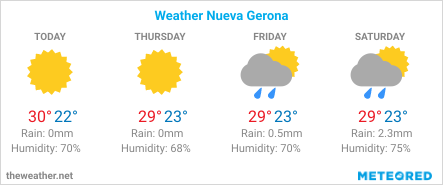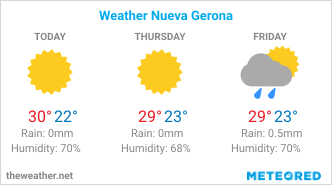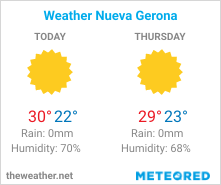 Weather and Climate
Weather and Climate
Cayo Largo has a subtropical climate that is divided into two seasons: the WET SEASON from May to October, and the DRY SEASON from November to April. The dry season is the busiest tourist season.
Cuba is located at the southwestern periphery of the North Atlantic high atmospheric pressure zone. Its climate is influenced by the northeast trade winds during the winter and east-northeast trade winds during the summer. Cayo Largo is a warm place to visit any time of year. Average day-time temperature usually ranges from 28 to 32 C (82 to 90 F), and night-time temperatures from 18 to 24 C (64 to 75 F). See the charts of monthly averages below.
Since Cayo Largo is located off the south coast of Cuba (in the Caribbean Sea), this is a place where you can expect slightly higher temperatures and a drier climate than most other Cuban tourist areas (most of them being on the north coast of Cuba). But evenings and nights might still be "cool" between late-December and early-March, we suggest packing a sweater or light jacket, just in case.
The hottest months are from June to September, but the trade winds and sea breeze help to keep things tolerable when the heat and humidity rise. During the wet season expect more mosquitoes and sand flies. It is suggested to always bring a good mosquito repellent (preferably with a high content of DEET), no matter when you travel.
September-October is the peak of the hurricane season, and consequently the cheapest time to travel. A major hurricane does not come every year, but when it does it can cause severe damages, floods, and ordered evacuations; such as the infamous Hurricane Michelle (category 4) that hit Cayo Largo on November 4th, 2001.
![]() To learn more about Cayo Largo's hurricane history, recovery efforts, and disaster relief projects, visit our sections:
To learn more about Cayo Largo's hurricane history, recovery efforts, and disaster relief projects, visit our sections:
Hurricanes
Hurricane Michelle.
The most enjoyable periods (weather-wise) are usually the transitional months between the two seasons, which are: March and April, and November to mid-December. These months are usually sunny and warm (both day and night), but without the hot and sticky discomfort of the summer months (May to October), and without the risk of “cooler” evenings (like in January and February).
Average High Temperature (Day time) in °C
Jan
28
Feb
28
Mar
29
Apr
29
May
31
Jun
31
Jul
32
Aug
32
Sep
31
Oct
31
Nov
29
Dec
28
Average Low Temperature (Night time) in °C
Jan
18
Feb
19
Mar
20
Apr
21
May
23
Jun
24
Jul
24
Aug
24
Sep
24
Oct
23
Nov
22
Dec
19
Average Rainfall (in mm)
Jan
35
Feb
39
Mar
39
Apr
46
May
143
Jun
194
Jul
127
Aug
167
Sep
199
Oct
125
Nov
56
Dec
20
Average Sea Temperature (in °C)
Jan
27
Feb
26
Mar
26
Apr
27
May
28
Jun
29
Jul
29
Aug
30
Sep
30
Oct
29
Nov
28
Dec
27
Average Number of Days with Rain
Jan
3
Feb
4
Mar
3
Apr
4
May
8
Jun
11
Jul
9
Aug
10
Sep
10
Oct
10
Nov
5
Dec
3
Here's the weather forecast for Nueva Gerona, the capital city of Isla de la Juventud and nearest major city to Cayo Largo:




souce: www.theweather.net
NOTE: You should never take too seriously the weather forecast for tropical destinations, such as the Caribbean, because the climate is unstable therefore very hard to predict, especially during the wet season (May to October) when rain is forecasted almost daily. It may indeed rain a little each day, but most often as a short tropical downpour (usually in late afternoon or at night), it rarely rains for several hours straight.
 Visit our website www.weathercuba.net
Visit our website www.weathercuba.net
to learn more about the climate and view the weather forecast for every tourist pole and some major Cuban cities.
Lily & Normand
© cayolargo.net
© destilino.com



